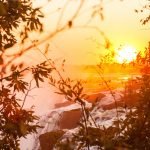James Sensenig, ND: In Memoriam; December 1, 2019
JARED ZEFF, with a little help from my friends
James Sensenig (“call me Jim”) was an intelligence officer in the US Army during the Viet Nam War. They picked the most capable people for that assignment. In 1974, he enrolled in the National College of Naturopathic Medicine (NCNM) and began one of the brightest careers this little profession has seen. As was necessary in those days, he became Dean of Academics upon graduation. The president of the college had graduated 1 year before that, along with the clinic director. When Jim began at NCNM, the profession was still licensed in 8 states. When he became Dean, that number had been reduced to 6, and this marked the lowest point to which the profession would recede.
The initial expansion of the profession, from its inception in 1896 to the closing of its last college in 1953, seemed to demonstrate the death of the idea that a medical profession based upon the principles of vitalism would persist beyond the lifetime of its founder, Benedict Lust. But a new college was formed in 1956 – NCNM – and the profession did not die, at least not quite. The last version of a national professional association went bankrupt in 1979. Only 4 of the 6 states had any professional naturopathic infrastructure: Oregon, Washington, Arizona, and Connecticut.
A Profession Reborn
In 1982, Jim began calling doctors he knew who had been active in the politics of the profession, newer graduates, and all the older doctors he could find. He put together a meeting in Las Vegas, and we agreed to form a new, national professional association. We each donated $200 from our pockets, and handed this money to a couple of these older doctors who had agreed to spearhead this effort. But nothing developed. Two years later, Jim called a smaller group, hand-picked, of people he personally knew. We met around a pool in Arizona and we set forth the outlines of a structure for a new, national professional association tasked with developing a new infrastructure for the political development of naturopathic medicine in North America. He called it the American Association of Naturopathic Physicians (AANP). It was modeled after the American Medical Association and the American Osteopathic Association, as a federation of State naturopathic professional associations.
Jim was elected the first president. Under his leadership, we set out several tasks: the development of a national accreditation board for our schools (CNME), a national licensure examination that was uniform and fair (NPLEX), a peer-reviewed journal to develop increased credibility for our medicine (JNM), a definition of naturopathic medicine not based upon modalities, that could be used for licensure as well as academic efforts, and a continuing education conference to fulfill licensure requirements and generate income for the association. Within 5 years, all of this had been accomplished, and the profession had a functional national association to work toward expanding licensure, based upon solid and legitimate standards and institutions.
Would any of this have happened without the leadership of Jim Sensenig? Possibly, but it was his continual effort, his guidance, and his vision that pulled it together. Part of his genius was to pick other leaders and assign them the tasks that needed doing, then work with them to accomplish these goals: Alan Gamble, Joe Pizzorno, Bill Mitchell, Carlo Calabrese, Ed Hofmann-Smith, Peter D’Adamo, Cathy Rogers, John Weeks, Teri Davis, Thom Kruzel, Jared Zeff, Pamela Snider, and so many others. But Jim was the universal ingredient.
He attended most of the necessary events, like the CNME hearings, available to spontaneously answer the questions of the legislative committee that turned the votes in our favor. Like Benedict Lust, he was at legislative hearings all around the country to testify in favor of naturopathic licensure. For this purpose, he created a “strike force” with Bob Timberlake and Harry Swope. He maintained a leadership role in the AANP through the turn of the century, and the candle-lighting ritual at every AANP conference was initiated by him. He was one of the 4 doctors who established the Foundations of Naturopathic Medicine Institute (FNMI) and its textbook project 12 years ago – to codify, preserve, strengthen, and advance naturopathic medicine’s unique philosophy, principles, and theory of practice. Jim was one of the 8 senior editors, and his writing is prominent in the Philosophy volume of the 4-volume textbook in production. He also co-created the Institute for Natural Medicine (INM) to engage philanthropy and advance public awareness, and he established the Naturopathic Medicine Institute (NMI) to sustain and further the teaching of vitalism in our profession and to call the profession back to its roots.
A Teacher of Vitalism
Jim also maintained, from the time of his graduation, a teaching role in our colleges. He not only served as Dean at NCNM, but also taught courses: gastroenterology and naturopathic philosophy at first. For at least 2 decades he taught naturopathic philosophy at Southwest College in Scottsdale, AZ. He was asked to serve as the founding dean at the new college in Bridgeport, CT, where he also taught philosophy. He taught more young doctors than anyone else in the profession, continuing at Southwest while also in CT. He developed a comprehensive presentation of vitalist medical philosophy that infused and inspired many young doctors. He testified incisively against tough political opponents and was a frequent speaker at many naturopathic medical conferences in the United States and Canada. He was honored on many occasions with the profession’s most prestigious awards, including an honorary Doctor of Naturopathic Philosophy degree from CCNM, the Beacon Award from the naturopathic medical students’ Gathering, the Dr Kenneth Harmon Award from the Northwest Naturopathic Physicians Convention (NWNPC), and the 1988 Physician of The Year award from the AANP.
He always saw himself as a link in the chain of advocates for vitalistic naturopathic medicine in the United States, beginning with Benedict Lust and continuing with Jim’s teachers and mentors, which included John Bastyr, William (Bill) Turska, Harold Dick, Robert Broadwell, and many others. He was a man of prodigious memory and sharp intellect, and was able to speak in great factual detail without any notes, spontaneously, as needed. His ability to recall and accurately quote from keystone naturopathic and homeopathic texts was legendary and was a powerful way of making everyone aware of the living legacy of healing knowledge provided by our vitalistic naturopathic predecessors.
Through all this, he maintained a full-time practice in Hamden, CT, where he not only worked his medical miracles, but also mentored many new doctors directly in his clinic. More of our colleagues had him as a mentor than anyone else in our profession.
We would see each other at these conferences as the years went by – several of us – and complain about the apparent reduction of the vitalist principle in our educational institutions. Students would come to our offices and be surprised that we used homeopathic medicine, that they would see autoimmune disease reversing, or that we treated pneumonia effectively without antibiotics. They would report that they were taught that this could not happen. These complaints led us to the creation of an ideal curriculum, on paper, of what a naturopathic physician should know, based upon the training we had received.
But this concern languished until Jim, Eli Camp, and Harry Swope got together, and once again a new effort was launched to restore vitalist education through a post-graduate institute. Jim used the Naturopathic Medicine Institute, NMI, for this purpose, and within the first year a simple phone conversation, open to listeners (the Vital Conversation), went from 20 doctors listening to Jim interview a colleague on the first call, to over 800 listeners each week. Vitalism was revived through a determined effort to provide education in the clinical skills any good vitalist should possess, using NMI’s VNMI curriculum, creating a growing cohort of vitalist practitioners throughout the profession and internationally. This was Jim’s final structural gift to the profession.
Remembered Always
Jim died early Saturday morning, November 30, peacefully in his sleep. We suspect he knew that his work was done, and that his efforts would persist through those of us left here who shared his passion for this medicine, a passion driven by the desire to heal the sick and ease human suffering through the restoration of health, guided by the principles he could expound upon so well. He left behind a huge number of doctors who considered him their personal mentor and guide. He left behind many friends and colleagues who cherish him – people with whom he had worked, influenced, and directed. Jim’s legacy, in this regard, and in regard to the institutions he developed and his accomplishments in gaining licensure and similar efforts, is unparalleled in this generation, and comparable only to the example of Dr Benedict Lust. He also leaves behind a grieving family – 3 children (Laura, Matthew and William), 4 grandchildren, his parents, siblings and others, as well as 4 decades of patients for whom he worked the clinical miracles that he used to point out were taken for granted in the daily practice of naturopathic medicine.
He loved Rumi’s poetry, dancing, and escaping to the Oregon coast. He was a deeply spiritual man.
Jim will forever be a giant in this medicine, respected and beloved by many, a teacher of many, a guide for many. More than anyone I know, he is responsible for the resurrection of naturopathic medicine in the latter 20th century. Jim’s legacy will continue, but he will be missed as we soldier on without him.









